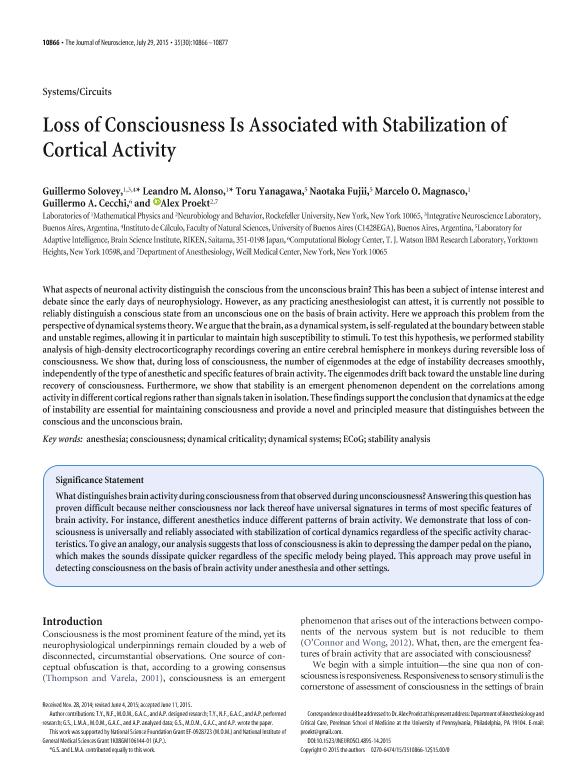Mostrar el registro sencillo del ítem
dc.contributor.author
Solovey, Guillermo

dc.contributor.author
Alonso, Leandro Martín

dc.contributor.author
Yanagawa, Toru
dc.contributor.author
Fujii, Naotaka
dc.contributor.author
Magnasco, Marcelo Osvaldo

dc.contributor.author
Cecchi, Guillermo Alberto

dc.contributor.author
Proekt, Alex
dc.date.available
2018-09-13T18:41:41Z
dc.date.issued
2015-07
dc.identifier.citation
Solovey, Guillermo; Alonso, Leandro Martín; Yanagawa, Toru; Fujii, Naotaka; Magnasco, Marcelo Osvaldo; et al.; Loss of consciousness is associated with stabilization of cortical activity; Society for Neuroscience; Journal of Neuroscience; 35; 30; 7-2015; 10866-10877
dc.identifier.issn
0270-6474
dc.identifier.uri
http://hdl.handle.net/11336/59582
dc.description.abstract
What aspects of neuronal activity distinguish the conscious from the unconscious brain? This has been a subject of intense interest and debate since the early days of neurophysiology. However, as any practicing anesthesiologist can attest, it is currently not possible to reliably distinguish a conscious state from an unconscious one on the basis of brain activity. Here we approach this problem from the perspective of dynamical systems theory. We argue that the brain, as a dynamical system, is self-regulated at the boundary between stable and unstable regimes, allowing it in particular to maintain high susceptibility to stimuli. To test this hypothesis, we performed stability analysis of high-density electrocorticography recordings covering an entire cerebral hemisphere in monkeys during reversible loss of consciousness. We show that, during loss of consciousness, the number of eigenmodes at the edge of instability decreases smoothly, independently of the type of anesthetic and specific features of brain activity. The eigenmodes drift back toward the unstable line during recovery of consciousness. Furthermore, we show that stability is an emergent phenomenon dependent on the correlations among activity in different cortical regions rather than signals taken in isolation. These findings support the conclusion that dynamics at the edge of instability are essential for maintaining consciousness and provide a novel and principled measure that distinguishes between the conscious and the unconscious brain. Significance Statement: What distinguishes brain activity during consciousness from that observed during unconsciousness? Answering this question has proven difficult because neither consciousness nor lack thereof have universal signatures in terms of most specific features of brain activity. For instance, different anesthetics induce different patterns of brain activity. We demonstrate that loss of consciousness is universally and reliably associated with stabilization of cortical dynamics regardless of the specific activity characteristics. To give an analogy, our analysis suggests that loss of consciousness is akin to depressing the damper pedal on the piano, which makes the sounds dissipate quicker regardless of the specific melody being played. This approach may prove useful in detecting consciousness on the basis of brain activity under anesthesia and other settings.
dc.format
application/pdf
dc.language.iso
eng
dc.publisher
Society for Neuroscience

dc.rights
info:eu-repo/semantics/openAccess
dc.rights.uri
https://creativecommons.org/licenses/by-nc-sa/2.5/ar/
dc.subject
Anesthesia
dc.subject
Consciousness
dc.subject
Dynamical Criticality
dc.subject
Dynamical Systems
dc.subject
Ecog
dc.subject
Stability Analysis
dc.subject.classification
Otras Ciencias Biológicas

dc.subject.classification
Ciencias Biológicas

dc.subject.classification
CIENCIAS NATURALES Y EXACTAS

dc.title
Loss of consciousness is associated with stabilization of cortical activity
dc.type
info:eu-repo/semantics/article
dc.type
info:ar-repo/semantics/artículo
dc.type
info:eu-repo/semantics/publishedVersion
dc.date.updated
2018-09-13T13:12:37Z
dc.journal.volume
35
dc.journal.number
30
dc.journal.pagination
10866-10877
dc.journal.pais
Estados Unidos

dc.journal.ciudad
Washington
dc.description.fil
Fil: Solovey, Guillermo. The Rockefeller University; Estados Unidos. Universidad de Buenos Aires. Facultad de Ciencias Exactas y Naturales. Departamento de Física. Laboratorio de Neurociencia Integrativa; Argentina. Universidad de Buenos Aires. Facultad de Ciencias Exactas y Naturales. Instituto de Cálculo; Argentina. Consejo Nacional de Investigaciones Científicas y Técnicas; Argentina
dc.description.fil
Fil: Alonso, Leandro Martín. The Rockefeller University; Estados Unidos. Consejo Nacional de Investigaciones Científicas y Técnicas; Argentina
dc.description.fil
Fil: Yanagawa, Toru. RIKEN Brain Science Institute; Japón
dc.description.fil
Fil: Fujii, Naotaka. RIKEN Brain Science Institute; Japón
dc.description.fil
Fil: Magnasco, Marcelo Osvaldo. The Rockefeller University; Estados Unidos
dc.description.fil
Fil: Cecchi, Guillermo Alberto. IBM Research. Thomas J. Watson Research Center; Estados Unidos
dc.description.fil
Fil: Proekt, Alex. The Rockefeller University; Estados Unidos. Weill Medical Center; Estados Unidos
dc.journal.title
Journal of Neuroscience

dc.relation.alternativeid
info:eu-repo/semantics/altIdentifier/doi/http://dx.doi.org/10.1523/JNEUROSCI.4895-14.2015
dc.relation.alternativeid
info:eu-repo/semantics/altIdentifier/url/http://www.jneurosci.org/content/35/30/10866
Archivos asociados
